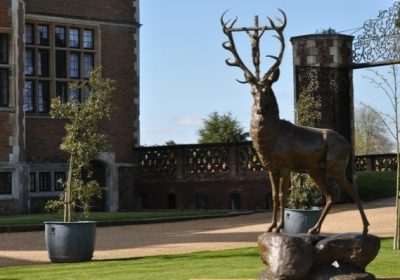Hatfield House
Description
Season 5th April 2014 – 28th September 2014


Our 2014 visitor season runs from 5 April – 28 September 2014. Please note: we are closed Good Friday, 18 April 2014.
Stable Yard Shops and the Coach House Restaurant are also closed until Saturday 15th February 2014.
Hatfield Park Farm and Bloody Hollow Play Area will reopen on Saturday 15th March 2014.
For full details please see our Opening Times & Prices page.
Built by Robert Cecil, Ist Earl of Salisbury and Chief Minister to King James I from 1607 to 1611. There is a marvellous collection of pictures, furnishings and historic armour on display The Estate has been in the Cecil family for 400 years, one of England’s foremost political families.
Where Elizabethan history began




The Cecils’ former home was at Theobalds, also in Hertfordshire. In 1607, Elizabeth’s heir, James I offered to exchange Theobalds for the Old Palace and manor of Hatfield. A draft Parliamentary Act of exchange survives in the Cecil Papers at Hatfield, dated May 1607. Salisbury began building work immediately. The main architect of the house was Robert Lemynge but Simon Basil, the Surveyor of the King’s Works and Inigo Jones also contributed to the design.
Salisbury had been appointed Lord Treasurer in April 1607 as well as Chief Secretary, but, he became ill and died, aged only 48, in April 1612. Although he was buried in Hatfield, he didn’t live to enjoy the house that was to become the home of his descendants for the next 400 years.


The Garden




Following the fashion for landscape gardening and some neglect in the 18th century, restoration of the garden started in earnest in Victorian times. Lady Gwendolen Cecil, younger daughter of Prime Minister Salisbury, designed the West Garden as it is today. The East Garden was laid out by the 5th Marquess of Salisbury. The present Dowager Lady Salisbury dedicated 30 years to the restoration and improvement of the garden. However, gardens evolve and there are many new features and some delightful planting to enjoy.


In the garden can be found the Great Hall, the surviving wing of the Royal Palace of Hatfield (1485) where Elizabeth I spent some of her childhood. This building is now known as the Old Palace and is used extensively for entertaining.


Today, the garden to the West of the house, which includes the Herb, Knot and Wilderness areas, can be seen when the house is open. However, all 42 acres, including the Kitchen Garden and the formal parterres to the East of the house leading down to the lake, are open especially for garden enthusiasts on Thursdays during the Visitor Season.


There is a play area for younger visitors with plenty of grassy space for running around. Picnic tables are provided under the trees to while away a pleasant afternoon.
Hatfield Park has so much to offer visitors of all ages and differing interests. Apart from Hatfield House itself, which has a fascinating history and makes for a fantastic journey through four centuries of dynamic change; you can enjoy the manicured garden, extensive park, 9 unique shops, a busy restaurant, a new traditional breeds farm and children’s adventure playground featuring a model of Hatfield House as a centerpiece and a sculpture exhibition.
Visitor Information
The House Office
Hatfield House
Hatfield
Hertfordshire
AL9 5NQ
Fax: 01707 287033


